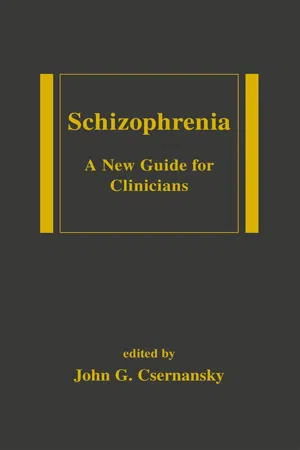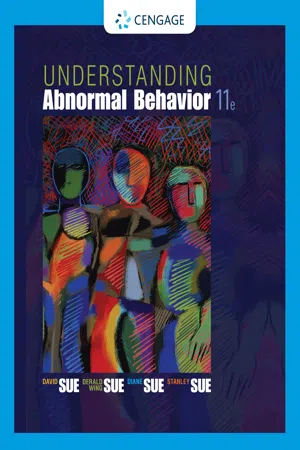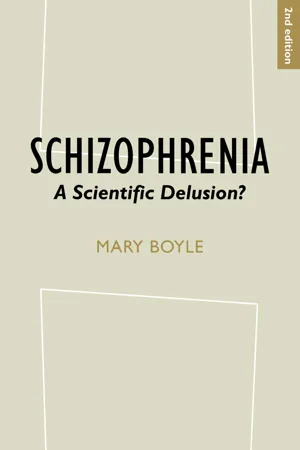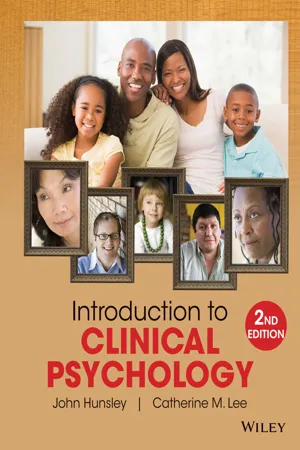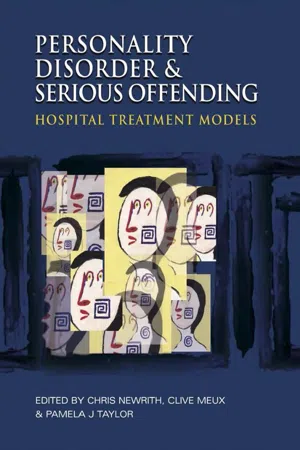Psychology
Diagnosis and Classification of Schizophrenia
The diagnosis and classification of schizophrenia involves identifying symptoms such as delusions, hallucinations, disorganized thinking, and negative symptoms. The DSM-5 criteria are commonly used for diagnosis, requiring the presence of specific symptoms for a certain duration. Subtypes of schizophrenia, such as paranoid, disorganized, and catatonic, were previously used for classification, but the DSM-5 emphasizes a dimensional approach.
Written by Perlego with AI-assistance
Related key terms
1 of 5
10 Key excerpts on "Diagnosis and Classification of Schizophrenia"
- eBook - PDF
- Jair C. Soares, Samuel Gershon, Jair C. Soares, Samuel Gershon(Authors)
- 2003(Publication Date)
- CRC Press(Publisher)
6 Classification of Schizophrenia and Related Psychotic Disorders TONMOY SHARMA and PRIYA BAJAJ Clinical Neuroscience Research Centre, Stonehouse Hospital, Dartford, Kent, England I. INTRODUCTION The need for a classification of mental disorders has been clear throughout the history of medicine, but there has been little agreement on which disorders should be included and the optimal method for their organization. The many nomenclatures that have been developed during the past two millennia have differed in their relative emphasis on phenomenology, etiology, and course as defining features. Some systems have included only a handful of diagnostic categories whereas others have included thousands. Moreover, the various systems for categorizing mental disorders have differed with respect to whether their principal objective was for use in clinical, research, or statistical settings [1]. Attitudes to psychiatric classification have also undergone a revolution in the last generation. In the 1950s and 1960s, psychiatric diagnoses did not occupy center stage in clinical practice. Their reliability was known to be low; it was known that key diagnostic terms like schizophrenia had different meanings in dif-ferent parts of the world. On the other extreme, there were some who argued that diagnostic categories should be abandoned and they believed that all patients require the same treatment—the ‘‘moral regime’’ of the asylum for Neumann and Prichard in the 19th century, and psychotherapy of Rogers and Menninger in the 20th century [2]. However, a clear definition and accurate classifica-tion of a disorder are the first steps in any systematic attempt to understand the pathophysiology and etiol-ogy of the disorder. The revolution in biological psy-chiatry can, in part, be attributed to advances in nosology [3]. - eBook - PDF
Schizophrenia
A New Guide for Clinicians
- John G. Csernansky(Author)
- 2002(Publication Date)
- CRC Press(Publisher)
53 Differential Diagnosis of Schizophrenia Del D. Miller and Susan K. Schultz The University of Iowa Iowa City, Iowa INTRODUCTION Schizophrenia is one of the first diagnoses that should come to mind when a clinician encounters a patient experiencing delusions, hal-lucinations, disorganized speech, grossly disorganized or catatonic behavior, or negative symptoms (i.e., affective flattening, alogia, or avolition). However, the clinician must keep in mind that there is no one pathognomonic feature of schizophrenia. The above symptoms can, and often do, occur in other psychiatric, neurological, and medical conditions, as well as with certain medications and substance abuse (1). It cannot be emphasized enough that no single feature (e.g., cross-sectional symptomatology, course, family history, response to treatment, or laboratory findings) will alone determine a diagnosis of schizo-phrenia. In general, the reliability of differentiating schizophrenia from the other disorders is strengthened by the presence of several of these characteristic features occurring in a manner consistent with the persistent courses and social/occupational impairment as outlined in the fourth edition of the Diagnostic and Statistical Manual of Mental Disorders (DSM-IV) (2). 3 54 Miller and Schultz In the absence of a clear pre-existing psychotic disorder, every patient with an acute episode of psychosis should have a thorough medical workup, including medical and psychiatric histories, medica-tion history, physical and mental status examination, and laboratory evaluation, including urinalysis and toxicology screens (3,4). A detailed history should be elicited from the patient and from family members and other informants regarding any previous episodes of psychotic symptoms or other psychiatric symptoms. The time course and treat-ment response to any previous treatments should be documented as well. - No longer available |Learn more
- David Sue, Derald Wing Sue, Stanley Sue, Diane Sue, David Sue, Derald Wing Sue, Diane Sue, Stanley Sue(Authors)
- 2020(Publication Date)
- Cengage Learning EMEA(Publisher)
However, it is not without its own set of controversies. Although the DSM is widely used in the United States, another important clas-sification system is the International Classification of Disease (ICD). This system cov-ers all health conditions, including mental disorders. The World Health Organization oversees the system. In recent years, the DSM diagnostic definitions have more closely resembled the ICD classification of mental disorders; however, there are significant differences between the two diagnostic systems. All of the DSMs are based on the classification system Emil Kraepelin developed around 1850. Kraepelin believed that mental disorders were like physical disorders, each with a specific set of symptoms. Thus, the DSM has traditionally been a cat-egorical system, listing disorders and the various characteristics, course, and out-come associated with each. Like physical disorders, the diagnostic process involves deciding whether a person has a particular disorder (Shorter, 2010). The process of diagnosing mental disorders, however, is complex because disorders often have over-lapping symptoms, making it difficult to distinguish one from another. For example, depressive and anxiety disorders share some of the same symptoms and have common neurobiological underpinnings and responsiveness to antidepressant medications (Nasrallah, 2009). To add to the complexity, the number of identified psychological disorders has increased dramatically over time. In 1840, the U.S. census had only two categories of mental disorders—idiocy or insanity (Cloud, 2010). - eBook - ePub
Schizophrenia
A Scientific Delusion?
- Mary Boyle(Author)
- 2014(Publication Date)
- Routledge(Publisher)
Chapter 4 The official correspondence rules for inferring schizophrenia 1 The development of diagnostic criteriaOfficial guidelines as to what should be observed for schizophrenia to be inferred have been set out in a series of publications by the World Health Organization (WHO) and the American Psychiatric Association (APA). WHO guidelines for inferring schizophrenia are included in the medical manual, The International Statistical Classification of Diseases and Related Health Problems, previously The International Classification of Diseases, Injuries and Causes of Death. Their inclusion there implies that the concept of schizophrenia is similar to concepts used in medicine and that the activity of psychiatric diagnosis is similar to that of medical diagnosis. The guidelines for inferring schizophrenia are therefore best examined, and the problems surrounding them best understood, in the context of a general discussion of medical diagnosis. The first part of this chapter will therefore be concerned with describing the activity of medical diagnosis and its theoretical background, as well as with some of the most frequent misconceptions to be found in the literature on psychiatric diagnosis. The second part will describe and evaluate the early development of ‘official’ diagnostic criteria for inferring schizophrenia.The nature of diagnosisThe word ‘diagnosis’ is derived from Greek and means to distinguish, to discern through perception. It is unfortunate that the term has come to be closely associated in the public mind with ‘finding out what is wrong with someone’ or with their functioning, and, indeed, has even been used in this way by some professionals (e.g. Silberman, 1971; Clare, 1976; Wakefield, 1999a, 1999b). Just as misleadingly, Kendell (1975b) has described ‘diagnosis’, in its active sense, as ‘the process by which a particular disease is attributed to a particular patient’ and, as a noun, as ‘the decision reached, the actual illness attributed to that individual’ (23). These definitions are unfortunate not only because Kendell’s reifies concepts inferred from various biological and behavioural phenomena, and misleadingly calls them diseases and illnesses, but also because they obscure the complexity and variety of activity subsumed under the term ‘diagnosis’. They also obscure its relationship to the activities of non-medical scientists. Given that users of the concept of schizophrenia claim scientific status for it, i.e. claim that their activities in relation to it are similar to the activities of other scientists in relation to their concepts, it is particularly important that these two aspects of diagnosis are not obscured if we are to evaluate claims made about ‘schizophrenia’. - eBook - ePub
Forensic Psychiatry
A Lawyer's Guide
- Vivian Shnaidman(Author)
- 2016(Publication Date)
- Academic Press(Publisher)
4 Diagnosis v. Jargon Some Common Psychiatric Diagnoses, and What Exactly Is Schizophrenia, Anyway? Abstract Though the Diagnostic and Statistical Manual of Psychiatric Disorders (DSM) is an important manual that every lawyer and doctor should have in their office, it is only a small representation of the field of psychiatry. The benefits of the DSM are the ability to communicate with health insurance companies, mental health treatment providers, and the legal system. But, the DSM does not cover the full range of mental illness that many providers see in their offices each day. This chapter will introduce you to some of the common language used in psychiatry. Particular attention is paid to psychosis and its associated issues: alternate reality and thought disorder. The legal definition of insanity and the concept of time in relation to psychiatry will also be covered. Case examples are given for illustration. Keywords Alternate reality; Clear sensorium; Diagnosis; DSM; Federal insanity statute; Grandiosity; Psychosis; Thought disorder; Time What Is the DSM and How Should It Be Used? The DSM or Diagnostic and Statistical Manual of Mental Disorders, currently in its official fifth edition (i.e., the DSM-V) is a book published every so often by the American Psychiatric Association. Although we discussed it in an earlier chapter, we will recap a bit here. The DSM is created and written by a committee. It is essentially based on what a bunch of middle-aged white guys sitting in Washington think comprises mental illness and the entire field of psychiatry. That said, it is considered the definitive text on psychiatry, the ultimate diagnostic tool, and it is the official document which psychiatrists and other people in the mental health field use to communicate with each other. However, there is a huge caveat. The people who walk into your office will very rarely have any of the disorders listed in this book - eBook - PDF
Introduction to Psychiatry
Preclinical Foundations and Clinical Essentials
- Audrey Walker, Steven Schlozman, Jonathan Alpert(Authors)
- 2021(Publication Date)
- Cambridge University Press(Publisher)
F. If there is a history of autism spectrum disorder or a communication disorder of childhood onset, the additional diagnosis of Schizophrenia is made only if prominent delusions or hallucinations, in addition to the other required symptoms of schizophrenia are also present for at least a month (or less if successfully treated). The following course specifiers are to be applied only after a 1-year duration of the disorder: First episode, currently in acute episode; First episode, currently in partial remission; First episode, cur- rently in full remission Multiple episodes, currently in acute episode; Multiple episodes, currently in partial remission; Multiple episodes, currently in full remission Continuous Unspecified Pattern Specify if: With catatonia (note that catatonia is not specific to schizophrenia and can be seen in other conditions) Specify current severity: Severity is rated by a quantitative assessment of the primary symptoms of psychosis on a scale of 0 (not present) to 4 (severe). The diagnosis can be made without using this severity specifier. 104 Schizophrenia Spectrum and Other Disorders In DSM-5, schizophrenia is defined by a group of characteristic symptoms, such as delusions, hallucinations, negative symptoms; deterioration in social, occupa- tional, or interpersonal relationships; and continuous signs of the disturbance for at least six months (Table 5.1). The tenth edition of the International Classifica- tions of Disease (ICD-10) system, which is used in many countries, is broadly com- parable to the DSM classification, although it differs in some details. For example, schizophrenia can already be diagnosed after thirty days of typical symptoms, and no deterioration in function is required. Schizoaffective Disorder Schizoaffective disorder is characterized by a combination of symptoms found in patients with schizophrenia and in patients with mood disorders. - eBook - PDF
- Jonathan Y. Tsou(Author)
- 2021(Publication Date)
- Cambridge University Press(Publisher)
25 5 Psychiatric Classification and the Pursuit of Diagnostic Validity The Diagnostic and Statistical Manual of Mental Disorders (DSM), pub- lished by the American Psychiatric Association (APA), is the most authori- tative psychiatric classification manual. Historically, the third edition of the DSM (DSM-III) was decisive in establishing its scientific credibility. DSM- III introduced its purely descriptive approach to classification, whereby mental disorders are defined by a set of necessary and sufficient ‘diagnostic criteria.’ While DSM-III improved the (interrater) reliability of its 25 These considerations demonstrate that the contrast Zachar (2000, 2014, ch. 9) draws between ‘natural kinds’ and ‘practical kinds’ is not as stark as he presents. The account of HPC kinds defended herein offers a naturalistic account that can explain the ‘stable patterns’ or ‘pragmatic successes’ sought by the practical kinds model. 44 Philosophy of Science categories, the DSM has failed to provide valid diagnostic categories that accurately represent real classes. This is largely due to its theorization of mental disorders as discrete disease-syndromes. I argue that the DSM should reconceptualize its objects of classification as biological kinds. I subse- quently examine Tabb’s argument, which draws on methodological assump- tions of the Research Domain Criteria (RDoC): the DSM has failed to formulate valid categories because its definitions generate heterogenous groups of patients unsuitable for discovering biomedical facts. Tabb’s assessment neglects a more basic problem with the DSM: its failure to revise its categories to incorporate scientific findings. To address this problem, the DSM should replace its purely descriptive methodology with a causal meth- odology, which would provide a more transparent and testable approach for formulating valid diagnostic categories. - eBook - PDF
- John Hunsley, Catherine M. Lee(Authors)
- 2017(Publication Date)
- Wiley(Publisher)
The adoption of this approach has allowed clinical psychologists to draw on a vast literature about parenting, child neglect and abuse, the effects of conflict on family members, cognitive changes over the life course, and changing societal values when considering diagnostic issues. Diagnosis No diagnosis is based on a single symptom. Diagnostic criteria always include a cluster of symptoms that co-occur. Medical students often report that, in learning about different disor- ders, they recognize symptoms that they have experienced and worry that they may suffer from the serious disorder they are studying. Parents, too, hear about symptoms that are associated with childhood disorders and may be tempted to speculate that the child at the next table in a restaurant who is whooping with delight and flicking food at a friend may have a diagnosis of attention-deficit/hyperactivity disorder (ADHD). developmental psychopathology: a framework for understanding problem behaviour in relation to the milestones that are specific to each stage of a person’s development. Josie Elias/Getty Images Without knowing the context of a person’s behaviour, we cannot say whether that person’s behaviour is normal. 54 CHAPTER 3 Classification and Diagnosis The diagnosis of mental disorders involves challenges that are less common in the diagnosis of physical conditions (Hyman, 2010). Most medical diagnostic systems focus not only on symptoms but also on the etiology of the condition and the ways in which external agents or external causes (such as bacteria, infectious agents, or malnutrition) gave rise to symptoms. Data from laboratory tests such as X-rays, ultrasound scans, and blood tests provide markers for many physical disorders and diseases. To date, there are virtually no comparable lab tests available for mental disorders. As a result, classification systems for mental disorders rely almost entirely on the observation of symptoms. - eBook - PDF
Introduction to Clinical Psychology
An Evidence-Based Approach
- John Hunsley, Catherine M. Lee(Authors)
- 2014(Publication Date)
- Wiley(Publisher)
Exhibit 3.1 lists some of the purposes of diagnostic systems used by psychologists and psychiatrists. Most health care practitioners find diagnostic systems useful, for all the reasons listed in the exhibit. Despite the advantages of diagnosis, there are also possible drawbacks, such as stigmatization of the person receiving the diagnosis and the potential for an inaccurate diagnosis to result in harmful or inappropriate treatment. Most clinical psychologists (whether practicing in an institutional setting such as a hospital or in a private practice setting) are required to diagnose a patient to determine if the patient is eligible for certain services (e.g., extra academic support for students with learning disabilities). Furthermore, many insurance companies require a diagnosis before authorizing reimbursement of the charges for psychological services. As you learned in Chapter 1, modern attempts to classify and diagnose abnormal human behavior began with the work of Emil Kraepelin, whose initial examination of dementia praecox (now called schizophrenia) and manic-depressive insanity (now called bipolar disorder) laid the foundation for current psychiatric diagnostic systems. The so-called neo-Kraepelinian approach to classification has several specific characteristics. These include viewing each diagnosis as a medical illness, using specific criteria to define a category, and emphasizing the importance of diagnostic reliability (Blashfield, 1991). - eBook - PDF
Personality Disorder and Serious Offending
Hospital treatment models
- Christopher Newrith, Clive Meux, Pamela Taylor(Authors)
- 2006(Publication Date)
- CRC Press(Publisher)
This additional information will also shed light on which areas of a patient’s life are affected. DESCRIBING PERSONALITY DISORDER IN CLINICAL PRACTICE The psychiatric classification systems (ICD-10 and DSM-IV) divide personality disorders into various discrete categories (see Chapter 4). Trying to pigeonhole individuals into cate-gories is useful for research purposes to ensure like is being compared with like. It may also provide a convenient shorthand for communicating in very broad terms the sorts of problems an individual is likely to have. However, the categories have been criticized for their lack of specificity, the fact that they overlap and because reliability between clin-icians is very poor in identifying the individual categories (Perry, 1992; Livesley et al., 1994). In addition, providing personality disorder category labels does not provide the accurate information about the individual’s actual dif-ficulties and circumstances that is required to plan and prioritize interventions. Everyone has to develop their own way of organizing the information they collect about personality disorders. Allnutt and Links (1996) have suggested that clinicians be aware of the factors that raise suspicion that there might be a personality disorder and then ask a few brief screening questions to establish whether the individual has any features suggestive of each type of personality disorder. However, research has confirmed that clin-icians do not find a checklist of direct ques-tions about particular traits very useful in the clinical setting (Westen, 1997). For practical purposes, it has been suggested that it is more useful to undertake a functional assessment of personality. This is essentially a case for-mulation addressing the relevant areas of abnormal functioning (Gunn, 1993; Westen and Arkowitz-Westen, 1998).
Index pages curate the most relevant extracts from our library of academic textbooks. They’ve been created using an in-house natural language model (NLM), each adding context and meaning to key research topics.

